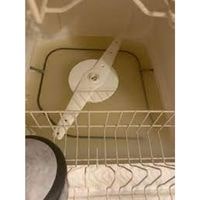Standing water in dishwasher. Many homeowners are alarmed when they notice water in the bottom of the dishwasher after it has been used. What can cause this, and why would there still be standing water near the sump pump if the tub is empty?
The amount of water left behind will help determine whether or not your dishwasher has developed a problem with its drainage system.
Standing water in dishwasher

One common reason for water at the bottom of your dishwasher is because food particles or other debris have clogged the drainage system.
Clean out the drain basket around the lower sprayer arm and use a wire hanger to unclog debris.
Faulty drain pump
Dishwashers can have pump motor problems of the electrical or mechanical variety.
One way to test if there’s a problem with the motor would be to check for electrical continuity, or in other words a complete continuous circuit through a path within the motor.
This would cause any lights on your dishwasher to light up correctly as well as allow it to continue spinning. If instead, your dishwasher testing meter shows no continuity when you test it then that means your dishwasher will need to install a new pump motor.
Remember some dishwashers only have one pump regardless of whether they’re designed for draining or washing and so this may not apply directly to your model.
Check drain hose

Both ends of a drain hose are prone to becoming clogged. Because of this, it’s important to take note of the drain hose’s orientation within your plumbing system before assuming a clog is present.
This will help you assess for kinks and other snags that could prevent water from draining properly.
It’s best to remove the drain hose from both the disposer/kitchen sink drain pipe and the dishwasher’s drain pump every now and then in order to clear away any unwanted obstructions.
Defective garbage disposer
When disposals are connected to garbage disposer hoses, food debris can get stuck in the disposal.
To avoid this problem, carefully push the plug into the drain tube for the garbage disposal before attaching any part of the hose.
If your garbage disposal is not working correctly, you may need to clean it with non-abrasive tools and chemical solutions like vinegar or bleach.
Fault with check valve

Dishwashers rely on a check valve to make sure water doesn’t keep getting dumped into the same tub over and over.
If the check valve gets stuck and the water just keeps going in, the washer won’t drain properly, and it will begin to flood your kitchen floor.
Normally this is easy enough to fix; you just need to tighten up the valve. But if that doesn’t work, you should probably try replacing it with a new one altogether.
Malfunctioning check ball
In some models, the check valve uses a check ball to prevent water from backing up into the tub. If a replacement part is needed, you can purchase most parts at hardware stores.
If your model’s come with an inaccurate or a faulty check ball, you can simply take it from another part of the assembly so as to avoid downtime costs.
Problem with drain solenoid valve
Some dishwasher models have a solenoid valve drain at the bottom of the tub. A solenoid valve is an electrically-activated switch that can open and close to control airflow, liquid flow through pipes, or similar activities.
If you suspect a malfunctioning solenoid in your dishwasher’s system, check whether current is flowing from one end of the valve to another by using a multimeter.
By doing this simple test for electrical continuity, you can directly determine whether this part has failed quite electronically or not.
How do I get rid of standing water in my dishwasher?
Remove any residue on the bottom of your dishwasher by pouring about one cup each of baking soda and vinegar down the drain, then allowing them to mingle for about twenty minutes.
This will create a chemical reaction that should help get rid of any build-up in the hose or basket. After twenty minutes, run hot water through the pipes to rinse out the mixture and complete your cleaning routine.
Can I manually drain my dishwasher?
To get to the water, it’s important to pull the dish rack out of the dishwasher so you can use it as a step. You can use an eyedropper to siphon out the water from the bottom of the machine.
As you siphon, place your bucket underneath and keep transferring all of that liquid into a larger container until you’ve reached capacity.
Standing water in dishwasher
Related Guide
